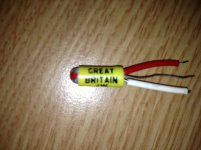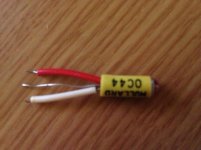I have acquired what I believe to be a yellow jacket mullard oc44. which appears to has a red dot at the top but not next to a pin. It comes from a radio. The centre pin is bare wire and the two outside pins are covered with (removable) insulation; one pin has white insulation (on the side of the oc44 with a black stripe), the other has red insulation. Can anyone tell me which pin is the collector, which the emmitter, and which the base,
Chears
Nick
Chears
Nick
Attachments
Are the legs evenly spaced coming out the bottom? Or are they in an arc? Look at a more modern metal small transistor, if you look at the bottom, three legs are in a circle with a space where a fourth one would have been. Kinda like this:
http://www.rfm.com/products/case/to39-3.pdf
http://www.rfm.com/products/case/to39-3.pdf
Base is normally the centre lead on all Germanium Transistors. The Collector will normally be the marked lead so that should be the one next to the stripe on the sleeve.
Thanks for all the help. I will go for the one next to the stripe being the collector. It's separation from the center pin is also a little greater, which also fits with Bibliophile's link. One more question, how likely am I to damage it if I get it wrong and the collector up to the positive of a 9V battery?
Well I wouldn't connect it up without testing it first. Have you a DVM with a transistor tester in it? What circuit are you using it in?
I was going to put it in this one http://www.geofex.com/Article_Folders/ffselect.htm
 please let us know how it goes
please let us know how it goesWell I appear to have killed it. The way of connecting discussed above was correct. I was getting a readout which converts to 12uA leakage (is this possible, it seems strangely low) and a hfe of 70. Then I decided to messure current through the 2.2M resistor (apparently foolish). The transistor got very hot and is now basically an open circuit between collector and emitter. Oh well. Some you lose.
Well I appear to have killed it.
don't worry about it
it's probably just a myth anyway 😛
but to the FF clone, and alternative transistors
I have noticed one suggesting BD139 is good, or BD140
Was actually going for the Rangemaster rather than the Fuzz Face. I got as far as the mocking up a pedal with some crocodile clips (before I decided to try to test it again more accurately). It sounded great when playing. I was getting a lot of noise when playing through my mocked up rig (the crocodile clips seemed to be responsible for a lot of noise, I have no idea why) and more so with the transistor, so I'm not sure if it was noisy or just boosting the noise from elsewhere. I have tried a few NOS Newmarket CV 8315s since, which do not sound anywhere near as good to me. Any recommendations for good rangemaster germaniums?
Any recommendations for good rangemaster germaniums?
dont know
other than maybe take inspiration from the axis face I mentioned
btw, I think the clips introduce noise partly because they are a somewhat loose grip
and the long wires for connecting, etc
might be its enough to drive a device to its limit and destroy it
dont know
other than maybe take inspiration from the axis face I mentioned
Thanks, will try.
btw, I think the clips introduce noise partly because they are a somewhat loose grip
I did wonder if that might be it. Could it be anything to do with sending the signal through a chunk of iron?
might be its enough to drive a device to its limit and destroy it
It seemed to be the attempted forward current measurement through the base resistor that killed it. I should read up on how the multimeters measure this but I'm guessing it may have been forcing current through the base that didn't want to be going through there
Muchas gracias
Nick
- Status
- Not open for further replies.
- Home
- Live Sound
- Instruments and Amps
- OC44 Yellow Jacket Pinout


